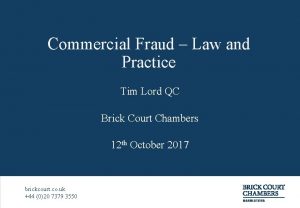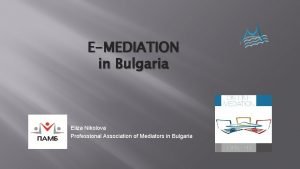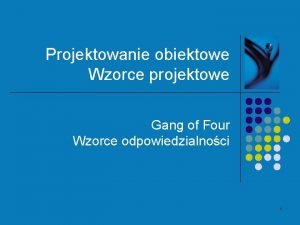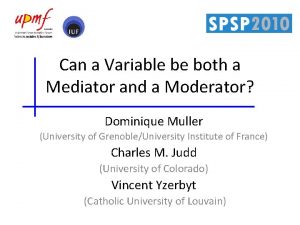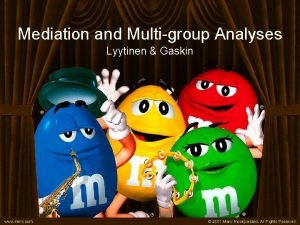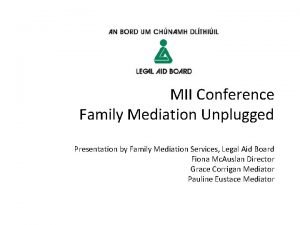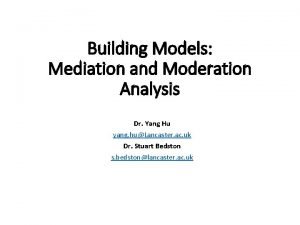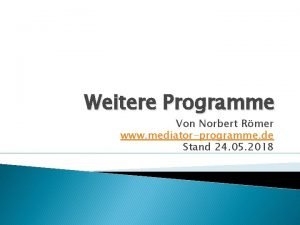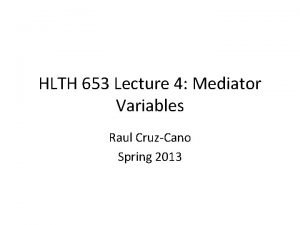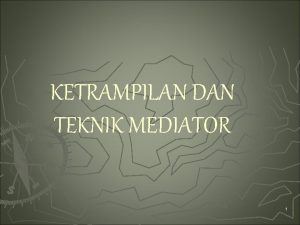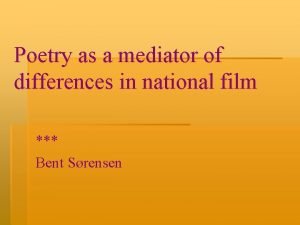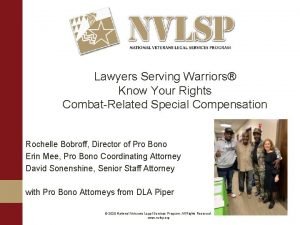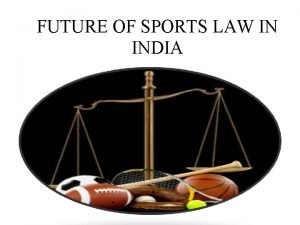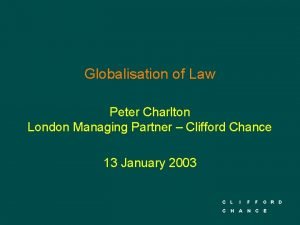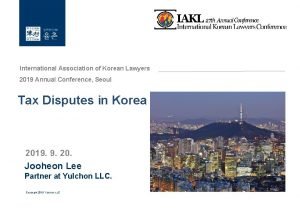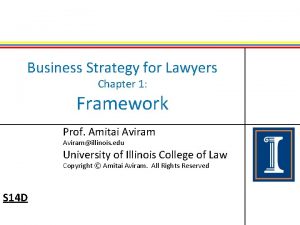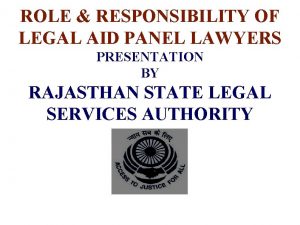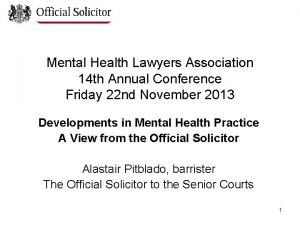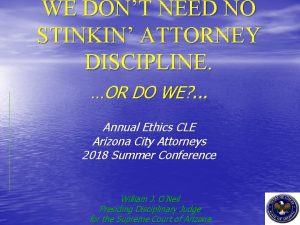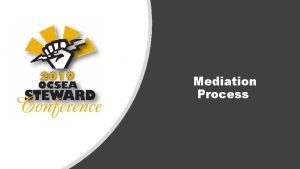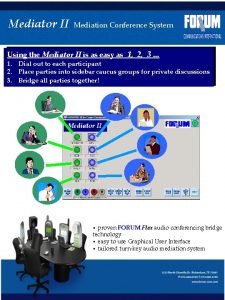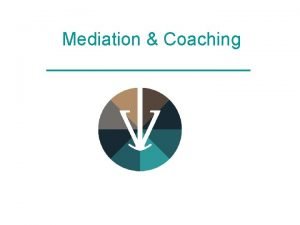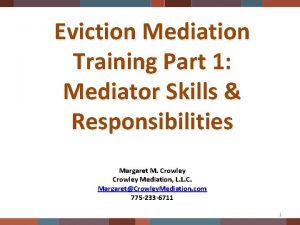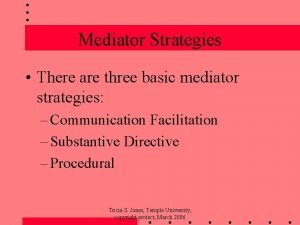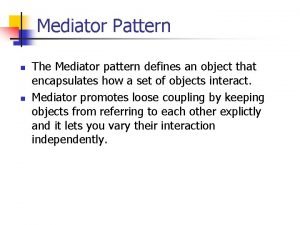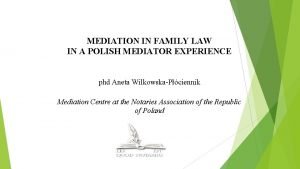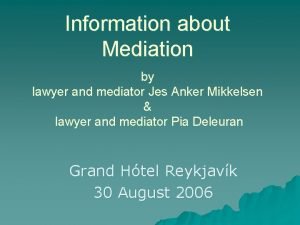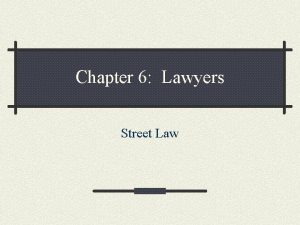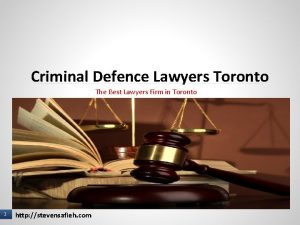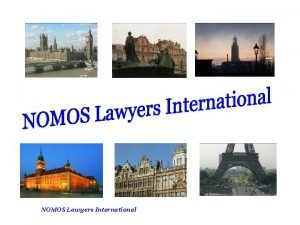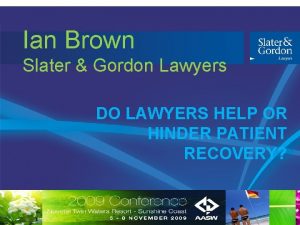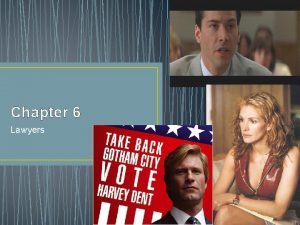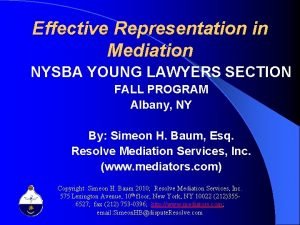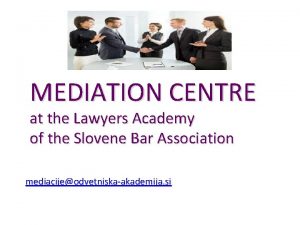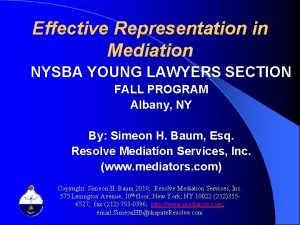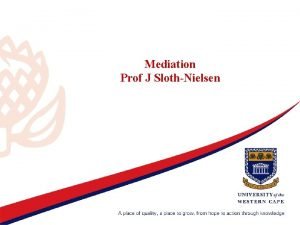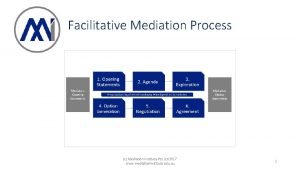Mediation Skills for Lawyers Margaret Halsmith Principal Mediator










![Mediation Stages • • • • Separate sessions [SS] Welcome Mediator’s opening Participants’ openings Mediation Stages • • • • Separate sessions [SS] Welcome Mediator’s opening Participants’ openings](https://slidetodoc.com/presentation_image/30929a8ec7acad176edabcb6ee51a760/image-11.jpg)








![Lawyers as champions of the process • • • • Separate sessions [SS] Welcome Lawyers as champions of the process • • • • Separate sessions [SS] Welcome](https://slidetodoc.com/presentation_image/30929a8ec7acad176edabcb6ee51a760/image-20.jpg)












- Slides: 32

Mediation Skills for Lawyers Margaret Halsmith Principal Mediator, Halsmith Dispute Resolution 1

Overview What is Mediation? How mediation is conducted Role of lawyers Mediation skills for lawyers Law Society WA © Halsmith Consulting Pty Ltd 2013 2

What is Mediation? Participant A, Participant B etc Dispute Law Society WA © Halsmith Consulting Pty Ltd 2013 3

What is not mediation? Party A v Party B © Halsmith Consulting Pty Ltd 2013 Law Society WA © Halsmith Consulting Pty Ltd 2013

What is mediation? Party A + Party B v issues © Halsmith Consulting Pty Ltd 2013 Law Society WA © Halsmith Consulting Pty Ltd 2013

Mediation or not? © Halsmith Consulting Pty Ltd 2013 • Zero sum negotiation • Party A v Party B Law Society WA © Halsmith Consulting Pty Ltd 2013 • Non-zero sum negotiation • Party A + Party B v issues

Mediation on Twitter @Halsmith. Dis. Res © Halsmith Consulting Pty Ltd 2013 • Mediation is parties’ participation in the facilitated shift – from competitive entitlement and authority – to cooperative problem-solving. • Mediation is parties’ participation in the facilitated shift – from a power struggle and clash of rights – to a melding of interests. • Mediation is parties’ participation in the facilitated shift – from self interest – to joint interests in order to meet self interests. Law Society WA © Halsmith Consulting Pty Ltd 2013

How do you know you are at a mediation? You and all others • • interact soft on the people; hard on the problem negotiate on interests; not on positions create options; not offers use objective standards; not arbitrary ones have a goal of a fair outcome for all agree on the basis of agreed principles proceed independently of trust Adapted from Fisher, Ury & Patten Law Society WA © Halsmith Consulting Pty Ltd 2013

How do you know you are not at a mediation? You or any of the other participants • • interact hard on the people; hard on the problem negotiate from positions; not on interests create offers; not options use created standards; not objective ones have a goal: to win or for TOS to acquiesce apply pressure or concede to pressure distrust others or rely on trust Adapted from Fisher, Ury & Patten Law Society WA © Halsmith Consulting Pty Ltd 2013

How Mediation is conducted Participants: substantive responsibilities t Mediator: procedural responsibilities Lawyers: substantive advisory & consultant responsibilities Law Society WA © Halsmith Consulting Pty Ltd 2013 10
![Mediation Stages Separate sessions SS Welcome Mediators opening Participants openings Mediation Stages • • • • Separate sessions [SS] Welcome Mediator’s opening Participants’ openings](https://slidetodoc.com/presentation_image/30929a8ec7acad176edabcb6ee51a760/image-11.jpg)
Mediation Stages • • • • Separate sessions [SS] Welcome Mediator’s opening Participants’ openings Mediator summaries Agenda Clarify & Explore Option generation Separate sessions Option reality testing Negotiation Recording decisions Closure Law Society WA © Halsmith Consulting Pty Ltd 2013 SS SS

Purpose of the stages of mediation • Separate sessions: – to assess for suitability and safety; to prepare including analyse and diagnose • Mediator’s opening: – to develop participants’ confidence; to maintain transparency • Participants’ openings: – to hear participants’ concerns, each equally significant • Mediator’s summary: – to acknowledge participants; parties to hear themselves and each other • Agenda: – to provide structure and focus Law Society WA © Halsmith Consulting Pty Ltd 2013

Purpose of the stages of mediation • Clarification and information gathering: – to broaden parties’ understanding of the issues: to frame the issues in terms of interests • Private sessions: – to check on participants’ experiences of mediation; to prepare for next phase • Option generation: – to identify broad range of potential components of an agreement • Option reality testing: – to test options for practicality • Agreement: – to confirm and document agreement if any, as appropriate • Closure: – to ensure loose ends are addressed Law Society WA © Halsmith Consulting Pty Ltd 2013

Q: How do you know you are at a mediation? A: Principled process • • • Interests focused Inclusive Value creating Voluntary, consensual Flexibility Participatory Informal Norm creating Cooperative • • • Situational, individualised Person-centred Relationship oriented Future focussed Peer-based Private, confidential Network Process focussed Parties as decision makers after Boulle 2005 Law Society WA © Halsmith Consulting Pty Ltd 2013

Q: How do you know you are not at mediation? A: Strategies and tactics • • • Ambit claim Low balling Split the difference Delay Deadline Attrition Persistence Shift focus Capitulation Law Society WA © Halsmith Consulting Pty Ltd 2013 • • • Act inconsistently Boredom Laughing Playing to the gallery Refuse to negotiate Take it or leave it Overload Lock in Walk out

Role of lawyers Take instructions t from client Trusted advisor to client Champion of the process Consultant to all Law Society WA © Halsmith Consulting Pty Ltd 2013 16

Wolski: the role of the lawyer in mediation • • • Advise clients of the law that applies Provide legal information [information maximisers] Encourage client to look at own & broader interests Generate options to meet broader interests Evaluate options from point of view of client and others Evaluate the merits of the case Project likely results in an adversarial setting Assess the likely litigated outcome Protect client against unfairness Promote informed consent Guide toward responsible decision making Adapted from Bobette Wolski Law Society WA © Halsmith Consulting Pty Ltd 2013

Lawyers as trusted advisors © Halsmith Consulting Pty Ltd 2013 • Listen assiduously for what is of concern and important • Think creatively to identify core issues and later to contribute options and to improvise • Speak optimistically about key issues, responsibilities and the future • Advise credibly when considering impacts and assessing risk; provide legal information • Conclude satisfactorily from client’s POV; commit to actionable steps Law Society WA © Halsmith Consulting Pty Ltd 2013

Attributes of the trusted advisor • • • Transparency Commonality Respect Caring Credibility Reliability Law Society WA © Halsmith Consulting Pty Ltd 2013
![Lawyers as champions of the process Separate sessions SS Welcome Lawyers as champions of the process • • • • Separate sessions [SS] Welcome](https://slidetodoc.com/presentation_image/30929a8ec7acad176edabcb6ee51a760/image-20.jpg)
Lawyers as champions of the process • • • • Separate sessions [SS] Welcome Mediator’s opening Participants’ openings Mediator summaries Agenda Clarify & Explore Option generation Separate sessions Option reality testing Negotiation Recording decisions Closure Law Society WA © Halsmith Consulting Pty Ltd 2013 SS SS

Lawyers as consultant to all • Principles of mediation – – Know them Understand them Analyse them to recognise them in their many forms Apply them in all aspects of each mediation • Process of mediation – Know it – Understand it in terms of the principles • Practice of mediation – Apply skills within the framework of the process Law Society WA © Halsmith Consulting Pty Ltd 2013

Participants’ roles © Halsmith Consulting Pty Ltd 2013 • Listen generously – 60%+ air time – Focus on the future • Think productively – Persevere through short backslides – Remain open to changing point of view – Participate in good faith Law Society WA © Halsmith Consulting Pty Ltd 2013 • Speak moderately – Contribute information and opinions • Decide wisely – Make substantive decisions • Conclude satisfactorily – Respectfully – Maintain confidentiality

Participants’ roles © Halsmith Consulting Pty Ltd 2013 Law Society WA © Halsmith Consulting Pty Ltd 2013

Mediation skills for lawyers t process into practice Putting the principles and Law Society WA © Halsmith Consulting Pty Ltd 2013 24

Listen assiduously for concerns & assist your client to listen generously © Halsmith Consulting Pty Ltd 2013 • • for interests for possibilities for acknowledgement for recognition for the future for respect for responsibility accepted for collective strengths Law Society WA © Halsmith Consulting Pty Ltd 2013

Think creatively & assist your client to think productively © Halsmith Consulting Pty Ltd 2013 • • • to add value to tolerate uncertainty to embrace inconsistencies to see holistic POV about the future to share responsibility to imagine options to explore ATNAs to diverge toward optimism Law Society WA © Halsmith Consulting Pty Ltd 2013

Speak optimistically & assist your client to speak moderately © Halsmith Consulting Pty Ltd 2013 • for themselves • with positive or neutral attributions • with curiosity • open questions • informally • referring to ‘what’s important’ • acknowledging the other • recognising responsibility of client • to explain how they agree • parties 60% air time; mediator 25% Law Society WA © Halsmith Consulting Pty Ltd 2013

Decide credibly & assist your client to decide wisely © Halsmith Consulting Pty Ltd 2013 • • sustainably practically holistically with dignity collectively lawfully based on reason & emotion Law Society WA © Halsmith Consulting Pty Ltd 2013

Recognise the conclusion & assist your client to conclude satisfactorily © Halsmith Consulting Pty Ltd 2013 • • mutually satisfactory generous at the end durable practical Law Society WA © Halsmith Consulting Pty Ltd 2013

in which all Mediation is facilitated strategic planning in a brief structured solution-focused process @Halsmith. Dis. Res © Halsmith Consulting Pty Ltd 2013 Law Society WA © Halsmith Consulting Pty Ltd 2013 • Listen generously for what matters underneath positions • Think creatively of blue skies • Speak moderately leaving space for dignified change of point of view • Decide wisely at each stage of the process • Conclude satisfactorily for participants

Mediation is parties’ participation in the facilitated shift from self interest to joint interests in order to meet self interests. © Halsmith Consulting Pty Ltd 2013 Skills = manifestation of role Role = to enhance the practice Practice = principles + process Law Society WA © Halsmith Consulting Pty Ltd 2013

Thanks to Felicita Sala for the use of her illustration throughout this presentation. http: //felicitasala. blogspot. com. au/ Law Society WA © Halsmith Consulting Pty Ltd 2013
 Mediator vs intercessor
Mediator vs intercessor Stephen ruttle mediator
Stephen ruttle mediator Mediator c++
Mediator c++ Jesus our mediator sermon
Jesus our mediator sermon Courtney bass mediator
Courtney bass mediator Gang of four memento and observer
Gang of four memento and observer Mediator psychology
Mediator psychology Mediator jesus
Mediator jesus Lynn cohn mediator
Lynn cohn mediator Respon suriah terhadap proklamasi kemerdekaan indonesia
Respon suriah terhadap proklamasi kemerdekaan indonesia Mediator vs. moderator variable
Mediator vs. moderator variable Mii mediation
Mii mediation Moderator vs mediator
Moderator vs mediator Mediator-programme
Mediator-programme Moderation vs mediation
Moderation vs mediation Parasympatikus
Parasympatikus Keterampilan dan teknik mediator
Keterampilan dan teknik mediator The mediator poem
The mediator poem Seapil
Seapil Lawyers serving warriors
Lawyers serving warriors Sports lawyers in india
Sports lawyers in india Immigration lawyer charlton
Immigration lawyer charlton Pro bono lawyers in alabama
Pro bono lawyers in alabama Horizon nj health prior authorization form
Horizon nj health prior authorization form Vermont association of criminal defense lawyers
Vermont association of criminal defense lawyers International association of korean lawyers
International association of korean lawyers Premium digital marketing for lawyers
Premium digital marketing for lawyers Business strategy for lawyers
Business strategy for lawyers Legal aid panel
Legal aid panel Mental health lawyers association
Mental health lawyers association Progress lawyers
Progress lawyers Lawyers oath
Lawyers oath Need for accountancy for lawyers
Need for accountancy for lawyers

